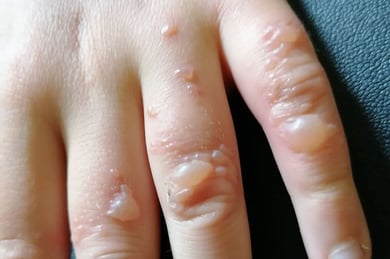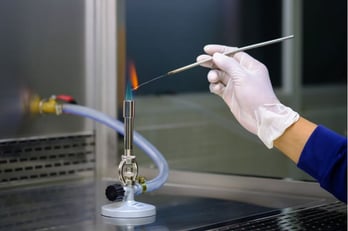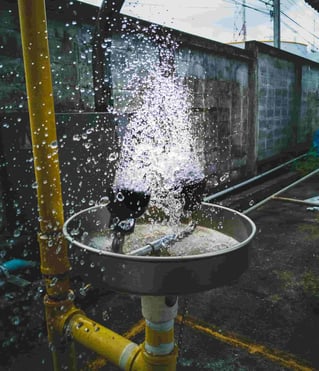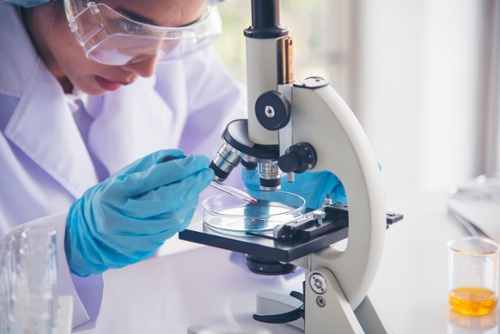If you work in a laboratory, you’ll understand that it requires great care and attention. With delicate lab instruments, hazardous chemicals and open flames, it is important to exercise caution in order to avoid safety hazards. Key hazards in the laboratory are those risks presented by the dangerous properties of hazardous chemicals. When harmful chemicals aren't handled in a safe and compliant manner, they can cause acute and chronic health problems. These problems may include burns, eye injuries, lung disease, asphyxiation and suffocation.
In this blog, we’ll discuss 5 examples of chemical and physical hazards, as well as explaining how to prevent chemical hazards in the laboratory.
1. Chemical Burns
Many laboratory chemicals are classed as corrosive substances, which have the potential to break down or degrade common objects such as equipment, instruments and containers.
Corrosive substances also pose a serious risk to your health. If a corrosive substance comes in contact with your skin, it will dissolve your flesh and cause severe damage to your body tissue. Even if you promptly wash the substance off your skin, corrosives can leave the skin irritated or with chemical burns. They can also cause issues with the eyes, damaging the cornea and potentially causing blindness.

Burns are a common type of hazard when dealing with harmful substances.
The good news is that chemical burns are simple to prevent with just a few basic measures:
- Compliant storage cabinet – If you’re working in a laboratory, you must make sure that the corrosives are kept in Class 8 dangerous goods storage cabinets that meet requirements of the Australia Standard AS 3780-2008. This Standard sets out the requirements for the safe and compliant storage of Class 8 Corrosive Substances.
- Safety signage – Signage is required to notify staff of the dangerous chemicals being stored and the hazards associated with them. Safety signage needs to be displayed at the entrance to the laboratory as well as on the chemical storage cabinets used to store the hazardous chemicals.
- Safety data sheets – Safety data sheets (SDS) should be kept close to the area that the chemicals are being stored in. Ideally, they should be located within a weather-proof document holder that’s attached to your chemical cabinet. This allows the staff in the lab to consult them if they require any technical information about the hazardous chemicals onsite.
- Personal protective equipment – in the event of an accidental chemical release, corrosive-resistant PPE, such as gloves and eyewear, is required so staff stay protected during the spill cleanup. Store these items in a PPE cabinet to ensure staff have easy access to the equipment, as well as preventing damage or disrepair to the equipment.
2. Heat Burns
Bunsen burners and other heating devices are commonly used in the lab to speed up chemical processes and reactions. Just like any activity involving fire, you must be cautious to avoid injuries such as heat burns.
If your skin is exposed to temperatures exceeding 70 °C - you will suffer a burn — even if your skin is exposed for as little as one second.

The heat generated by Bunsen burners can create a range of serious physical hazards for laboratory staff who are using the equipment.
It is important to keep a safe distance from any open flames or heating devices to minimise the risk of heat burns in the lab. Keep skin, clothing and protective equipment, as well as any other flammable materials in the nearby area, away from heat sources. It is also critical to ensure that you don’t leave a Bunsen burner on or unattended after use.
If you do suffer a heat burn while working in the lab, put the affected area immediately under cold running water immediately and hold it there for 10 minutes — or until the burning sensation goes.
3. Eye Injuries
It’s important to be aware of hazardous chemicals that are harmful to your eyes when working in the laboratory. Chemical exposure can occur if liquids or gases are accidentally released, damaging the eyes of workers. To avoid eye injuries in the laboratory, staff must wear the appropriate protective eyewear.
When hazardous chemicals come into contact with your eyes, it can result in minor or serious eye injuries. The extent of injury depends on the hazardous properties of the chemical — and the level of exposure. For example, a minor eye injury from chemical exposure could result in redness and irritation, while a more serious eye injury could cause permanent blindness.

The installation of a compliant eyewash facility is necessary to minimise the likelihood and impact of chemical hazards in the laboratory.
To ensure that your eyes are protected while in the laboratory, use eye protection when handling potentially harmful chemicals. If your workplace is deemed at risk of eye injuries from chemical splashes, an emergency eyewash facility is essential. Emergency eyewash stations will allow you to quickly flush harmful contaminants out of your eyes and prevent any further injury.
4. Cuts From Glassware
Many laboratories rely on glassware for holding and mixing dangerous chemicals. However, there is always the chance that laboratory glassware can break. Broken glass exposes sharp edges, especially when the glass is very thin.
This broken glass can cause serious damage to the eyes and skin, so care must be taken to minimise the likelihood of this occurring.
The best way to avoid cuts from glassware is to handle it with care. Always hold glassware firmly — and never with wet or slippery hands. Glassware can break if handled roughly, such as lab staff applying too much force when connecting two pieces of a glass apparatus.
In the event of a glass cut, it’s important to act immediately to prevent your wound from becoming infected. If you suffer a cut from glassware, you should contact your first aid officer who will then dress the wound.

You can minimise the likelihood of broken glassware becoming a physical hazard in your workplace.
As glassware ages, it can get brittle and become more susceptible to cracking and breaking. Therefore, it’s a good idea to regularly check your laboratory equipment and discard old glassware that may be prone to damage.
When glassware is not being used, it should be stored in a secure location where there is no risk of it falling and shattering. If glassware isn’t stored in a cupboard with an even and secure surface, it can also fall and break — putting staff at risk of a physical injury.
Does your lab need safety showers or eyewash stations?
Access our free eBook to learn more.
5. Inhaling Dangerous Gases
Many dangerous chemicals emit hazardous vapours and gases that are hazardous to human health.
The health effects from exposure to hazardous vapours can be either acute or chronic. Acute effects are those effects that are experienced immediately after contact with the vapours. Chronic effects are those effects that are not experienced immediately, but months and years after initial exposure.
One example of a dangerous gas often found in a laboratory setting is chlorine gas. Chlorine is a Class 8 substance which is widely used across a vast range of applications. This hazardous chemical is often used as a as a disinfectant or fungicide. Chlorine is also a necessary substance for the production of ethylene dichloride, vinyl chloride monomer, polyvinyl chloride resins and other materials.
While small, safe concentrations of this toxic chemical are found in our drinking water, swimming pools, cooling systems, pesticides and cleaning products, chlorine gas in high concentrations can result in poisoning.
Heath effects of chlorine gas inhalation can include symptoms such as:
- Irritation to mucous membranes in the nose, throat and respiratory tract
- Headache
- Vomiting
- Coughing
- Burning
- Difficulty breathing
This is just one example of a dangerous good that can have serious health effects if used or stored incorrectly. You will work with many types of hazardous chemicals while you are in the lab — such as flammable or corrosive chemicals — so it’s vital that your team are aware of the risks involved.
By understanding both the physical hazards and the chemical hazards that are present in your workplace, you can protect your people and property from harm caused by hazards in the laboratory.
How To Prevent Chemical Hazards in the Laboratory
We hope you now have a better understanding of some common chemical hazards in the laboratory. Our post has aimed to answer the question ‘What is a laboratory hazard’, by detailing incidents of human harm, such as heat burns, glass cuts, and the inhalation of gas.
Did you know that there are nine classes of dangerous goods — with each class emitting various harmful vapours with different hazardous properties? If chemical exposure occurs in a laboratory, such as a staff member inhaling toxic gases, it can result in serious human harm or even fatalities.
Therefore, to reduce the risks associated with chemical hazards in the laboratory, you may need to consider storing harmful chemicals in well ventilated chemical storage cabinets. By providing mechanical ventilation to your indoor chemical cabinets, you can help reduce exposure to these hazardous vapours.
If you’d like to learn more about the ventilation of chemical storage cabinets, why not download our free eBook today? Our guide will help you determine if ventilation is required and explains the requirements and your obligations when it comes to workplace air quality. You can access this helpful guide by clicking on the image below.
Joining the team as a Dangerous Goods Storage Consultant, Melissa Hampton became Storemasta's Marketing Manager in late 2021. With extensive knowledge and experience in chemical compliance, Melissa is responsible for leading the Marketing team and helping shape their marketing strategy. In her spare time, you can find Melissa hiking, swimming and enjoying the great outdoors in beautiful north-west Tasmania.
